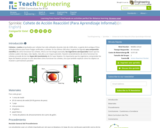
Los estudiantes construyen un cohete que se desplaza a lo largo de una cuerda.
- Subject:
- Engineering
- Science
- Material Type:
- Activity/Lab
- Provider:
- TeachEngineering
- Provider Set:
- Sprinkles
- Date Added:
- 01/01/2015

Los estudiantes construyen un cohete que se desplaza a lo largo de una cuerda.

This video from NASA describes the detailed computer modeling used to predict that colliding neutron stars can produce gamma-ray bursts similar to those associated with black holes.

As a continuation of the theme of potential and kinetic energy, this lesson introduces the concepts of momentum, elastic and inelastic collisions. Many sports and games, such as baseball and ping-pong, illustrate the ideas of momentum and collisions. Students explore these concepts by bouncing assorted balls on different surfaces and calculating the momentum for each ball.

This is a laboratory exercise designed to allow students to further investigate the light spectrum. This lab is used to have students view the light spectrum first hand as opposed to using lecture alone.

Watch the ZOOM cast find out how many balloons filled with air and then with water are required to support the weight of a cast member.

In this video segment, members of the ZOOM cast experiment by bending and folding sheets of paper into various shapes to see which shape will support the weight of a heavy book.

In this video segment from ZOOM, Hillary, from Randolph, MA, takes us on a tour of the columns in her neighborhood.

Have you ever wondered why it takes such a long period of time for NASA to build space exploration equipment? What is involved in manufacturing and building a rover for the Red Planet? During this lesson, students will discover the journey that a Mars rover embarks upon after being designed by engineers and before being prepared for launch. Students will investigate the fabrication techniques, tolerance concepts, assembly and field-testing associated with a Mars exploratory rover.
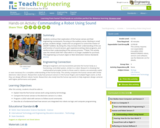
Students continue their exploration of the human senses and their engineering counterparts, focusing on the auditory sense. Working in small groups, students design, create and run programs to control the motion of LEGO® TaskBots. By doing this, they increase their understanding of the use and function of sound sensors, gain experience writing robot programs, and reinforce their understanding of the sensory process.

Students continue an examination of logarithms in the Research and Revise stage by studying two types of logarithms—common logarithms and natural logarithm. In this study, they take notes about the two special types of logarithms, why they are useful, and how to convert to these forms by using the change of base formula. Then students see how these types of logarithms can be applied to solve exponential equations. They compute a set of practice problems and apply the skills learned in class.

Students examine different types of fabric and their characteristics. Using magnifying glasses and sandpaper, they test and observe the weave and wear quality of fabric samples. By comparing the qualities of different fabrics they come to understand why so many different types of fabric exist and are able to recognize or suggest different uses for them.

In small groups, students experiment and observe the similarities and differences between human-made objects and objects from nature. They compare the function and structure of hollow bones with drinking straws, bird beaks, tool pliers, bat wings and airplane wings. Observations are recorded in a compare & contrast chart, and then shared in a classroom discussion, along with follow up assessment activities such as journal writing and Venn diagrams.
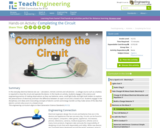
In the everyday electrical devices we use calculators, remote controls and cell phones a voltage source such as a battery is required to close the circuit and operate the device. In this hands-on activity, students use batteries, wires, small light bulbs and light bulb holders to learn the difference between an open circuit and a closed circuit, and understand that electric current only occurs in a closed circuit.
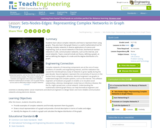
Students learn about complex networks and how to represent them using graphs. They also learn that graph theory is a useful mathematical tool for studying complex networks in diverse applications of science and engineering, such as neural networks in the brain, biochemical reaction networks in cells, communication networks, such as the internet, and social networks. Topics covered include set theory, defining a graph, as well as defining the degree of a node and the degree distribution of a graph.

In a multi-week experiment, students monitor the core temperatures of two compost piles, one control and one tended, to see how air and water affect microbial activity. They daily aerate and wet the "treated" pile and collect 4-6 weeks' worth of daily temperature readings. Once the experiment is concluded, students plot and analyze their data to compare the behavior of the two piles. They find that the treated pile becomes hotter, an indication that more microbes are active and releasing heat. Through this activity, students see that microbes play a role in composting and how composting can be used as a carbon management process.
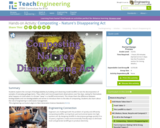
Students explore the concept of biodegradability by building and observing model landfills to test the decomposition of samples of everyday garbage items. They collect and record experiment observations over five days, seeing for themselves what happens to trash when it is thrown "away" in a landfill environment. This shows them the difference between biodegradable and non-biodegradable and serves to introduce them to the idea of composting. Students also learn about the role of engineering in solid waste management.

Meet Carlos Garcia, a Computer Engineer for a data science company called 8451. Carlos builds applications that help Kroger supermarkets track shipments and keep food on their shelves. Engineering Your Future shares real stories from young professionals who want to inform and inspire students about in-demand engineering careers.
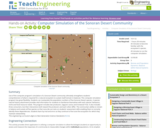
The computer program's simulation of a Sonoran desert community should ultimately strengthen the student's comprehension of what is required for a natural ecosystem to sustain itself (remain in balance). This computer simulation program has great flexibility. It allows the student to manipulate the population numbers of five Sonoran Desert species. A species natural history attachment provides vital information for the students to familiarize themselves with each species' behaviors, its niche and food resource needs. The program includes two producers, the Saguaro cactus and the Ironwood Tree. It also includes 3 consumers, but their interactions both toward the producers and each other differ. The community's ability to remain in balance and sustain all five species so that none die out rests on the student's assessment skills enabling him to correctly identify these dependencies. The student learns by trial and error as he continues to fine tune the ecosystem that he maintains stewardship of.

Meet Claude Nicol, a Computer and Electronic Engineer at Wright Brothers Institute Center for Rapid Innovation. He builds new inventions called "prototypes" to solve problems for the US Air Force. Engineering Your Future shares real stories from young professionals who want to inform and inspire students about in-demand engineering careers.

Students investigate the property dependence between concentrations and boiling point. In section 1, students first investigate the boiling point of various liquid solutions. In section 2, they analyze data collected by the entire class to generate two boiling point curves, one for salt solutions and one for sugar solutions. Finally, in section 3, students use the data they have analyzed to determine how to create a solution that has a particular boiling point and is a cost-effective design.